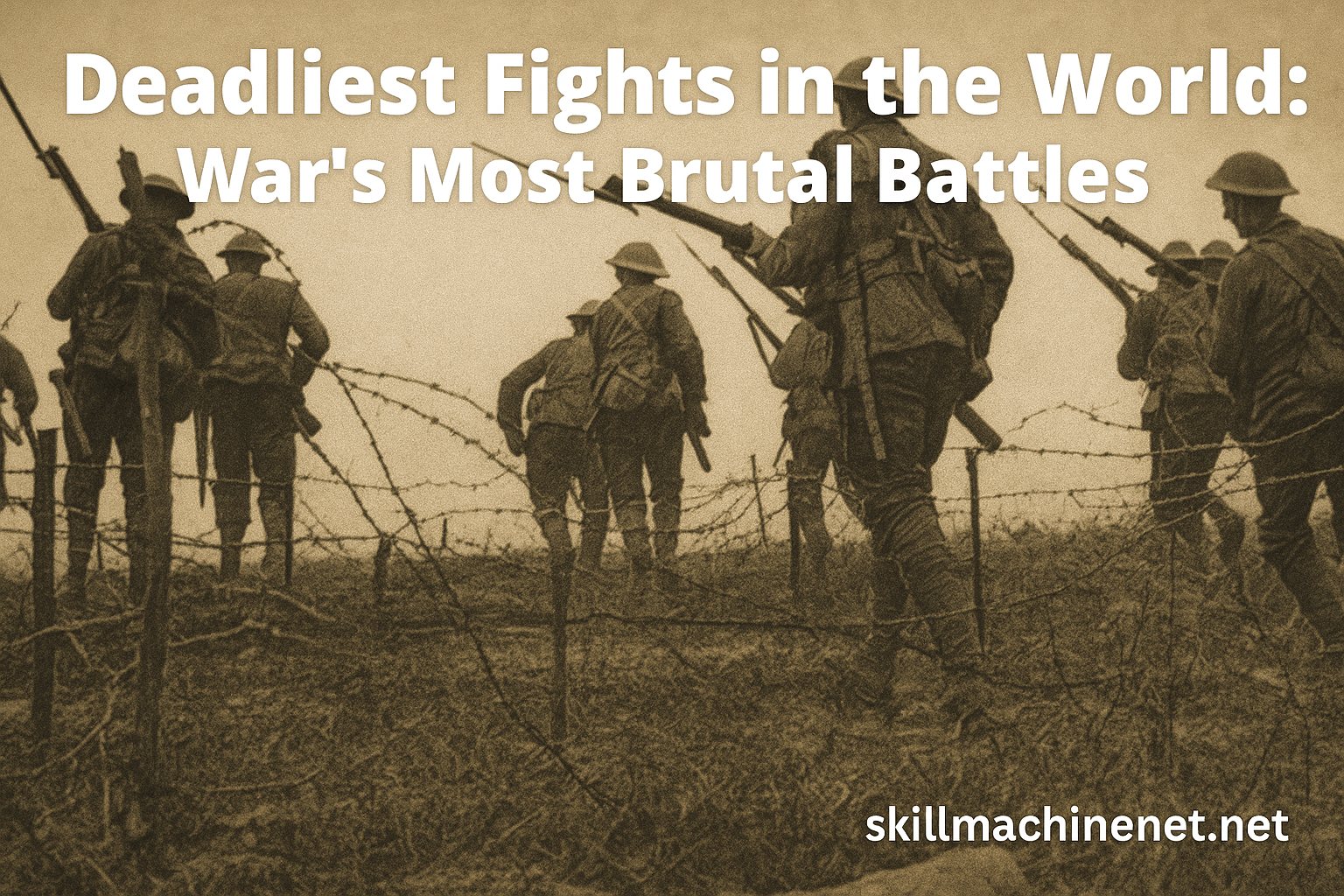War has changed civilizations, removed empires, and defined borders throughout time. While all wars are a tragedy to themselves, there are some wars that stand out for their devastation, men killed, and overall effects. From as far back as ancient sieges to modern air wars these life taking struggles embody the longevity of mankind and the incredible toll of violence against humans.
Throughout the article, we will outline some of the most deadliest struggles in recorded history, and examine its causes, tactics as well as the human toll from these disasters.
The Battle of Stalingrad (1942–1943)
Estimated death toll: 2 – 2.5 million
Location: Stalingrad (now Volgograd), Russia
Parties involved: Nazi Germany vs. Soviet Union
The Battle of Stalingrad is often regarded as the bloodiest battle in modern history, with a significant impact on World War II. For seven grueling months, forces from Germany and the Soviet Union fought brutally for control, literally from building to building. Massive ground offensives and even aircraft bombing campaigns completely leveled neighborhoods. Soldiers fought in sewers, factories, and rubble. The German 6th Army was encircled and ultimately surrendered, marking a serious defeat for Hitler’s war machine.
How was it so deadly:
• City vs. city combat
• Stalin’s retreat or die policy
• hunger and freezing temperatures
• civilians caught in the middle
The Siege of Leningrad (1941–1944)
Estimated death toll: 1.5 to 2 million
Where did this happen? Leningrad (now Saint Petersburg), Russia
Fighting parties: Nazi Germany and Finland, versus Soviet Union
The Siege of Leningrad lasted for an amazing 872 days. The city was encircled around food, water and fuel supplies. The populace suffered extreme starvation, some resorting to the wallpaper paste or animals. Thousands were dying every single day while in the brutal Russian winters. This was not a purely military operation, but a cruel and savage attempt to annihilate a city, primarily through attrition.
Key Factors:
- Starvation as a weapon
- Constant artillery fire
- Frozen supply routes (over Lake Ladoga)
- Minimal military action maximum impact to civilian populace
The Battle of Okinawa (1945)
Estimated casualties: Over 200,000 (civilians included)
Location: Okinawa, Japan
Warring Parties: United States vs Imperial Japan
The last large battle of World War II, Okinawa featured one of the largest and most complex amphibious assaults in history. The Japanese dug in infantry fought tooth and nail for every part of the island, utilizing caves and tunnel systems. In coordination with this ground fight, Japanese air forces sent kamikaze aircraft into the battle resulting in heavy naval casualties. Throughout the fight civilians faced intense violence, including forced suicide brought on by Imperial Japanese military orders.
Why it was brutal:
• Extended, close combat
• High level and intensity of suicide (civilians)
• Kamikaze incidents
• Psychological trauma on both warring sides
Siege of Baghdad (1258)
In 1258, Baghdad a center of learning, culture, and science was attacked by the Mongol army of Hulagu Khan. Once referred to as the jewel of the Islamic Golden Age, Baghdad fell in two weeks. What ensued was one of the greatest massacres in history. Almost two million were killed, including civilians. Libraries burned, scholars were killed, and centuries of knowledge were lost in mere days. The destruction was total and it was a collapse of an entire intellectual tradition.
Key Takeaways:
Loss of priceless cultural and scientific property
Use of psychological warfare to cause fear
Destruction of Baghdad’s infrastructure
A tragic end to the Islamic Golden Age
India Pakistan Aerial Skirmish (2025)
Approximately fatalities: Multiple pilots; risk of supplementary escalation
Location: Line of Control, Kashmir
Combatants: India vs. Pakistan
Although not yet begun, the theoretical 2025 dogfight between India and Pakistan represented one of the biggest jet battles since WWII. With 100+ jets in the air at once, both nations illustrated the volatility of nuclear capable countries in regions with territorial disputes.
Why it matters:
• Modern air combat capabilities
• Drone and AI weaponry
• Risks of high speed decision-making
• Possibility of nuclear escalation from errors
The Battle of the Somme (1916)
Estimated losses: More than 1 million
Location: France
Combatants: Britain and France vs Germany
The Somme was World War I’s deadliest battle and a horrific example of trench warfare. On just the first day alone, Britain lost over 57,000 including 20,000 dead. A number not surpassed in their military history. Because of their poor tactics and egregious command decisions, coupled with indiscriminate artillery shelling, the overall loss of life was large with little ground gained.
Factors of brutality:
• Muddied trenches and disease
• Sheer magnitude of artillery shelling
• Infantry assaults “Over the top” into machine-gun fire resolution
• Despite great losses, no tactical gains
Common Traits of the World’s Deadliest Fights
Civilian Participation
Not only did modern, as well as medieval battles, have vast effects on civilians (starvation, bombing, mass executions… etc).
Urban Warfare
Warfare in urban terrain increases damages- civilian buildings are part of the battleground, increasing DPAs and infrastructure collapse.
Time Span
Probably many of the most damaging fights lasted months, or years allowing cumulative damages to mount up.
Psychological Warfare
From the siege tactics of the Mongols to kamikaze attacks in Okinawa, fear was a destructive weapon.
Why These Fights Still Matter Today
These past occurrences allows us to avoid future catastrophes. Many of these deadly conflicts began as a failure of diplomacy, national arrogance pride, or miscalculation of the opponent. The interactions that produced these disasters have meaning today, especially in an environment of geopolitical tension.
Some examples of lessons learned:
• Diplomacy prevents incitation (India-Pakistan)
• In a conflict it is our duty to protect urban population. (Stalingrad, Leningrad)
• Psychological damage to veterans and civilian population must be defused.
Read also: Misc Brands & Sites: Bonuses, Casinos, and Codes
Conclusion
The fiercest battles in history offer a deeper understanding of what it meant to be brutal they illustrate the impacts of reckless pride, ignorance and uncontained aggression. From medieval sacking and pillaging to trench warfare and air battles, every time humanity has made war we have left permanent scars. But they also give us a lesson, and they teach that there is value in diplomacy, being prepared, and the pursuit of peaceful associations.
When we recall history’s most deadly and dangerous battles, we can create a day when those acts of violence become a relics of the past.
FAQs
Q1. What was the most dangerous fight in history?
A: The Battle of Stalingrad is widely regarded as the deadliest single battle, with over 2 million casualties.
Q2. Which fight had the highest civilian deaths?
A: The Siege of Leningrad saw immense civilian suffering, with up to 1.5 million civilian deaths from starvation and bombings.
Q3. What makes a fight dangerous?
A: High casualties, urban combat, duration, and civilian impact make a battle especially deadly.
Q4. Can modern fights be as deadly as historical ones?
A: Yes, With nuclear weapons, cyber warfare, and drones, modern wars can be even more destructive, even in shorter durations.



